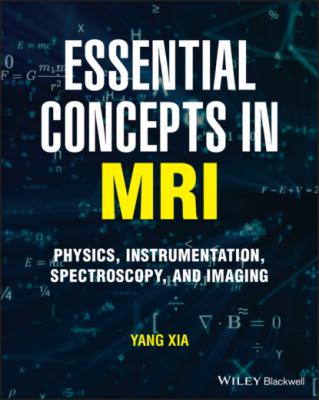ТОП просматриваемых книг сайта:
Essential Concepts in MRI. Yang Xia
Читать онлайн.Название Essential Concepts in MRI
Год выпуска 0
isbn 9781119798248
Автор произведения Yang Xia
Жанр Медицина
Издательство John Wiley & Sons Limited
4 Only the transverse component of the precessing M induces an observable signal in the receiver coil. The transverse component can be written as (2.25a) (2.25b)
where the complex i indicates a 90˚ phase shift (i = −1); v (which is in the direction of y′) is called the absorption spectrum, where the signal is proportional to the power absorbed from the EM field; and u (which is in the direction of x′) is called the dispersion spectrum (which is a common term in optics). Note that the signal is proportional to B1 not B12 [10].
2.10 RADIO-FREQUENCY PULSES IN NMR
A much more efficient method in modern NMR experiments is to apply a short but powerful B1 pulse, which has a duration of several to tens of µs. This rf pulse will be able to cover all possible resonance frequencies simultaneously in the specimen. The reason that a short pulse can excite all possible resonant groups in the specimen is because the frequency range of a 10 µs pulse is about 105 Hz (since f = 1/T), which is sufficient to cover the range of all resonant peaks due to the differences in their chemical shifts (e.g., the three peaks in the ethanol spectrum in Figure 1.4). Since the Larmor frequency in common NMR magnets is in tens or hundreds of megahertz (e.g., at B0 = 1 Tesla, f = γB0/2π = 42.6 MHz), this short B1 pulse is commonly called a radio-frequency (rf) pulse. It is customary to label a B1 pulse with the amplitude and duration to tip M by ϕ degrees as a ϕ rf pulse. More precisely, a 90˚| x′ pulse implies the B1(t) is stationary at the x′ axis in the rotating frame and is capable of tipping the magnetization by 90˚. By setting the central carrier frequency close to the nominal Larmor frequency ω0, one single pulse can excite all possible resonance frequencies.
There are two descriptive terms for an rf pulse, whether the pulse is soft or hard (Figure 2.13), and whether the pulse has a constant or modulated amplitude. A soft rf pulse refers to its narrow band in frequency, which would have a long duration in time (since f = 1/T); in contrast, a hard rf pulse would have a narrow time duration and hence a wide band in frequency, which is commonly used in NMR spectroscopy to excite all possible resonance frequencies. An rf pulse with a constant amplitude in time is commonly used in NMR spectroscopy, while an rf pulse with a modulated amplitude in time would result in a particular waveform in frequency, which is commonly used in MRI.
Figure 2.13 Fourier transform of (a) a hard rf pulse that is short in time duration and (b) a soft rf pulse that is long in time duration.
For a square or rectangular pulse where the B1 field has a constant amplitude during the pulse duration, the tipping angle is given by the area of the pulse, as
where tp is the duration of the pulse and B1 is its magnitude. When B1(t) does not have a constant amplitude during tp, the amount of rotation ϕ is then given by the time integral of the amplitude of the rf field, as
For a pulse whose frequency response is not uniform, the central portion of the frequency response (i.e., frequency range close to ω0) should have a constant amplitude so that all resonant groups centered around ω0 can experience similar tipping angles.
2.11 FT NMR
In contrast to the situation in CW NMR (Section 2.9) where each particular type of nucleus in a chemical is brought into the resonance individually and sequentially, the use of an rf pulse excites simultaneously all NMR-active nuclei in the chemical. This method of NMR experiments is called FT NMR, which is much more efficient than CW NMR and offers the opportunity of SNR improvement by co-addition of many spectral responses.
In an FT NMR experiment, a resonant rf pulse results in a non-zero transverse component of the magnetization M, which precesses in the transverse plane. This precessional motion of M can be detected by means of a receiver coil (often called an rf coil, cf. Chapte 5.2), which can sense the transverse electromotive force (emf) and produces an FID signal.
Immediately following a 90°|x′ pulse (i.e., after B1(t) has been turned off), M is given by
Subsequently, assuming a uniform field B0, the evolution of magnetization can be obtained by solving the Bloch equation, as
Since there is a 90˚ phase difference between Mx(t) and My(t), we can combine the two transverse components (the FID) expressed in Eqs. (2.29a) and (2.29b) into a complex term, as
The complex nature of the NMR signal means that we can measure not only the amplitude of the signal but also its phase, which is one of the remarkable advantages of NMR and MRI. In comparison, several other types of spectroscopy and imaging (e.g., Fourier transform infrared spectroscopy and imaging, computer tomography) can only measure the amplitude of the signal.
The time evolution of the Mx(t) and My(t) components are illustrated in Figure 2.14a and Figure 2.14b, where at t = 0 (the end of the 90˚ rf pulse), Mx(t = 0) = 0, and My(t = 0) = M0. The FT of the FID signal is a Lorentzian in the frequency

